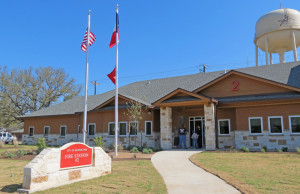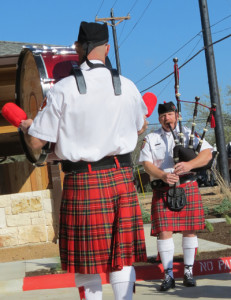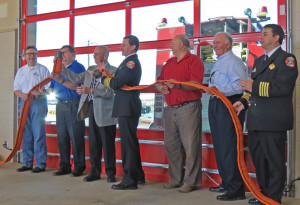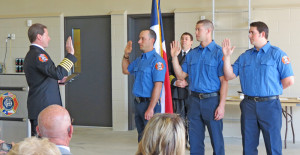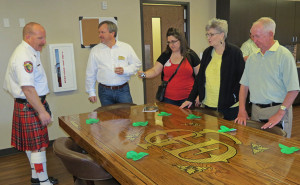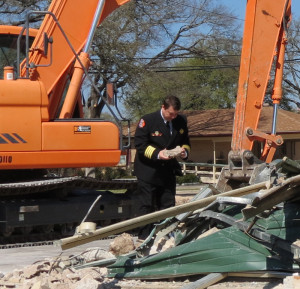Good Neighbor Fund Helps Families Through Difficult Times
Each month, families facing a serious crisis like a job loss or medical emergency seek help from local nonprofits like The Caring Place. That support, including assistance with utility bill payments, can make a crucial difference when it seems as though there is no place to turn.
Recently one family of eight was helped by the Good Neighbor Fund, a program sponsored by Georgetown Utility Systems and administered by The Caring Place.
When the father lost his job, suddenly the parents had no means to provide for their six children, ranging in age from 4 to 16. During the father’s two-month period of looking for work, The Caring Place helped with assistance for food, clothes, and utility bills. After this difficult time, both parents were able to find work again. The kids are doing fine as well.
The father of that family says the assistance from The Caring Place “made a huge impact upon helping out our family in a time of need. This also helped minimize the stress put upon my family and me on trying to feed the family while I looked for a new job. We are all very grateful to the genuine concern your organization showed towards my family in a time of need.”
Each month, a similar story plays out for many families in Georgetown. Your donation to the Good Neighbor Fund can help The Caring Place meet the daily need for emergency assistance.
City of Georgetown utility customers can make a monthly pledge online to The Good Neighbor Fund and change or discontinue that pledge at any time. It only takes a minute to fill out the online pledge form here. Call Customer Care at (512) 930-3640, or email customercare@georgetown.org for details.
Hazard Mitigation Plan Survey
The City of Georgetown is currently in the process of completing a Hazard Mitigation Plan. Input from the community is needed for the project team to identify and analyze potential hazards affecting residents and recommend possible actions to reduce their impact. Hazards can include droughts, floods, hurricanes, tornadoes, wildfires, and other major disasters.
A public participation survey is available online at www.surveymonkey.com/s/CityofGeorgetown.
The goal of the Hazard Mitigation Plan is to minimize or eliminate the long-term risk to human life and property from known hazards by identifying and implementing cost-effective mitigation actions. Mitigation is defined by the Federal Emergency Management Agency as sustained actions taken to reduce or eliminate long-term risk to people and property from hazards and their effects.
Questions about the Hazard Mitigation Plan should be addressed to H2O Partners, planning consultants for the project. Contact Cathy Meek with H2O Partners at (888) 328-4151, ext. 2, or by email at cathy@h2opartnersusa.com.
Airport Tower Funding From TXDOT and City Approved
Update: Today the FAA has delayed tower closures until June 15th. So the City contracts and funding of the tower will not begin until June 16th if TxDOT allows the grant to be extended to that date.
The Georgetown city council voted this morning to accept an emergency short-term grant from the Texas Department of Transportation to help fund staffing of the control tower at the Georgetown Municipal Airport. The TXDOT grant provides 90 percent of the funding for tower staffing by air traffic controllers. The City will fund the remaining 10 percent of the staffing cost. The city council approved the funding arrangement in a special meeting to address the tower funding issue.
The 90/10 funding arrangement is on an emergency basis for 90 days. The state and local money replaces federal funding from the Federal Aviation Administration that ends on April 7. Funding was cut for FAA contract employees at airport control towers as a result of sequestration federal budget cuts that took effect in March.
Yesterday, the Texas Transportation Commission approved the emergency state funding program for control towers at 14 airports in Texas. The TXDOT funding program is a reimbursement grant in which the City of Georgetown will pay the expected $158,687 cost to staff the tower for 90 days and will later be reimbursed by TXDOT for 90 percent of the cost. The City’s portion of the 90-day cost is projected to be $15,868.70. City funding will come from the Airport Fund or General Fund programs that have experienced cost saving in the 2013 Budget. Staff will present those options to City Council at the April 23rd regular meeting.
The city council also approved a contract with Robinson Aviation to provide the air traffic controllers to staff the control tower. Controllers with Robinson Aviation have worked under an FAA contract to staff the Georgetown control tower since it opened in 2007.
If FAA funding for tower operations is restored before the 90-day period, then the TXDOT and City funding for tower operations would be discontinued.
Semi-Wild Cats Are Ready for Farm Life
 Several semi-wild cats at the City of Georgetown Animal Shelter are still looking for a ticket to their next chapter as a barn or ranch cat. These cats are not fully acclimated to life indoors as a house pet, but can still have a good life and earn their keep on a farm or ranch.
Several semi-wild cats at the City of Georgetown Animal Shelter are still looking for a ticket to their next chapter as a barn or ranch cat. These cats are not fully acclimated to life indoors as a house pet, but can still have a good life and earn their keep on a farm or ranch.
There are currently eight semi-wild cats at the shelter that need homes in a barn or outbuilding says Jackie Carey, animal services manager.
Each cat is spayed or neutered and given their rabies vaccination. There is no adoption fee.
To introduce a semi-feral cat to your property, keep it in a barn, outbuilding, garage, or laundry room for a few weeks until the cat realizes that the new place is a safe home. Even though these cats are skittish around people, they do still need regular food and water.
For more information about a barn cat for your property, contact the Georgetown Animal Shelter at (512) 930-3592 or animalsvc@georgetown.org. The City of Georgetown Animal Shelter is located at 110 W.L. Walden Drive next to the McMaster Athletic Complex. The shelter website is pets.georgetown.org.
Georgetown in the Healthiest County in Texas
Georgetown is the county seat of the healthiest county in the state, according to a national ranking released yesterday. Williamson County is the #1 healthiest county in Texas in the 2013 County Health Rankings, an annual report by the University of Wisconsin Population Health Institute and the Robert Wood Johnson Foundation. Williamson County was ranked the #2 healthiest county in Texas in the 2012 report.
The annual ranking is a quality of life report card that grades counties on a wide variety of factors such as community safety, employment rates, graduation rates, healthcare access, health care quality, longevity, and health behaviors.
One of the factors considered in the County Health Rankings was recreational programs and facilities. “The evidence for the effectiveness of improving access to recreational facilities is so strong that the Centers for Disease Control and Prevention recommend it as one of the 24 environmental- and policy-level strategies to reduce obesity,” according to the report.
The positive effects of strong public safety and low crime rates in Williamson County were also key factors in the ranking, with community safety contributing to outcomes such as birth weight, diet and exercise, and family and social support.
Many organizations and businesses in the county play a role in contributing to the quality of life ranking, including schools and universities, parks and recreation programs, hospitals, health clinics, nonprofit organizations, workplace wellness programs, law enforcement, and economic development efforts.
The rankings are available online at www.countyhealthrankings.org.
Fire Station 2 Dedication Photos
The Georgetown Fire Department dedicated the new Fire Station 2 on Williams Drive this morning. (Click on photos for a larger version.)
Elected officials and community members joined the Fire Department to open the new station. The facility was open for tours after the ceremony.
The Georgetown Fire Department Pipes and Drums Band played at the ceremony.
A ceremonial hose uncoupling, the fire service version of the ribbon cutting, officially opened the new station. Pictured left to right are Council Member Jerry Hammerlun, City Manager Paul Brandenburg, Mayor George Garver, Fire Chief John Sullivan, City Council Member Bill Sattler, Mayor Pro Tem Danny Meigs, and Assistant Fire Chief Clay Shell.
At the dedication, Fire Chief John Sullivan inducted three new firefighters who took the oath of office: Clint Gray, Aubrey Reeves, and Chad Roberts.
In the new station, each firefighter working on a shift has a dorm room with a bed and locker.
The station has a fitness room with free weights and machines.
Battalion Chief Jeff Davis tells people on the tour about a custom wood dining table made by the firefighters. Two fire hydrants serve as pedestals for the table.
After the ceremony, Assistant Fire Chief Clay Shell picks up a piece of masonry from the old Fire Station 2, which is being demolished. Shell worked as a firefighter in the old station for several years in the 1990s.
The old Fire Station 2 behind the new station was only 1,600 square feet compared to 8,300 square feet for the new station. After the old building is torn down, the area will become green space.
The new fire station was built on property the City acquired next to the old station, which allows fire trucks to exit directly onto Williams Drive, improving visibility for cross traffic. The new Fire Station 2 has three truck bays and houses an engine company as well a hazardous-materials unit. The station provides coverage for much of the central part of the city and downtown.
The new Fire Station 2 was designed by KAH Architecture from Round Rock and built by Chasco Constructors from Round Rock.
Wild Cats Need New Life on the Ranch
The City of Georgetown Animal Shelter is looking for good homes for some semi-wild cats. They are not really suited to indoor living, but can earn their keep and be perfectly happy as barn cats.
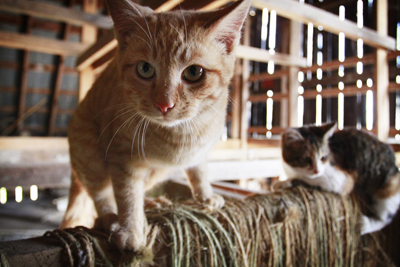 Jackie Carey, animal services manager, says 19 cats were recently taken from a home in Georgetown. “They’re pretty cats. They’re seal point and lynx point,” says Carey.
Jackie Carey, animal services manager, says 19 cats were recently taken from a home in Georgetown. “They’re pretty cats. They’re seal point and lynx point,” says Carey.
Each cat is spayed or neutered and given their rabies vaccination. There is no adoption fee.
To introduce a semi-feral cat to your property, keep them in a barn, garage, or laundry room for a couple of weeks until they realize that the new place is a safe home. Even though these cats are skittish around people, they do still need regular food and water.
For more information about a barn cat for your property, contact the Georgetown Animal Shelter at (512) 930-3592 or animalsvc@georgetown.org. The City of Georgetown Animal Shelter is located at 110 W.L. Walden Drive next to the McMaster Athletic Complex. The shelter website is pets.georgetown.org.
Georgetown Main Street Program Recognized
For the 11th consecutive year, the Georgetown Main Street Program was recognized with national accreditation. The honor was conferred last week at the winter meeting of the Texas Historical Commission’s Texas Main Street Program. Georgetown was one of 67 accredited Main Street programs in Texas that were recognized at the January 30 conference in Llano.
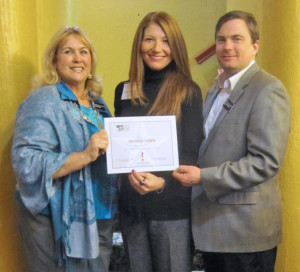 “It really is a notable accomplishment to be recognized in this way, especially for those programs that do it year after year,” said Debra Farst, Texas Main Street Program state coordinator. “Incremental progress that leads to comprehensive success is at the core of the preservation-based Main Street model and that is exactly what these programs are showing. Each program is recognized for their own local effort. They are truly real places telling real stories.”
“It really is a notable accomplishment to be recognized in this way, especially for those programs that do it year after year,” said Debra Farst, Texas Main Street Program state coordinator. “Incremental progress that leads to comprehensive success is at the core of the preservation-based Main Street model and that is exactly what these programs are showing. Each program is recognized for their own local effort. They are truly real places telling real stories.”
Accredited programs show above average performance in ten categories on an annual report. Selection criteria focus on planning, partnerships, staffing, volunteer effort, preservation ethic, training, and program assessment through reporting. The state office also works with programs throughout the year by providing various services based upon local needs.
Pictured in the photo are Debra Farst, Texas Main Street Program state coordinator, Shelly Hargrove, Georgetown Main Street Program manager, and Brad Patterson, division director, Community Heritage Development Division, Texas Historical Commission.
In 2012, the Georgetown Main Street Program awarded $24,400 in façade and sign reimbursement grants to eight downtown businesses. Events and programs in 2012 include the Georgetown Swirl wine and food event, the Main Street 30th Anniversary Dinner Celebration, the Light Up the Square holiday lighting campaign, and the annual collectible ornament sale. Since 2003, the Georgetown Main Street Program has awarded $226,995 in façade and sign reimbursement grants to downtown businesses.
For more information about the Georgetown Main Street Program, go to mainstreet.georgetown.org. View the Texas Historical Commission’s Main Street program site for more information.


.png)



